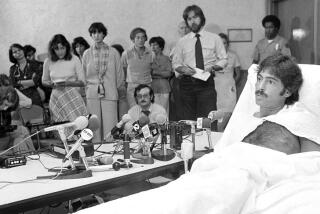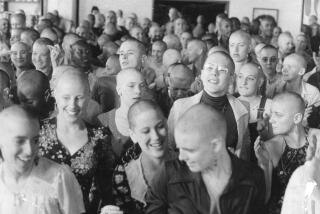The Legacy of Vidal Sassoon
Ppay a call on a famous hairdresser? the man who practically invented modern hair? I’m a wreck. Will my style be judged wanting? Roots showing? Bangs raggedy?
But Vidal Sassoon just smiles when I ask if women always react to him in this way. “I’m usually looking in their eyes, darling.”
And, in fact, he is looking into my eyes. Raggedy bangs? What raggedy bangs?
Even though he hasn’t cut hair for two decades, there’s something eternally seductive about Sassoon. He knew what women wanted before they knew it themselves. It wouldn’t be a drastic overstatement to say that he did for women’s hair what the pill did for their sex lives: He made it easy.
Perhaps Sassoon’s charm is simply reflexive salesmanship. After all, he’s been the public face of a popular company for decades. (“If you don’t look good,” he used to purr in the commercials, “we don’t look good.”) Yes, he sold his company years ago: The line of hair products went to Richardson-Vicks, which in turn sold to Procter & Gamble. The salons and academies went to longtime Sassoon employees. But he continues to unleash his charm around the globe, receiving royalties as he travels for the megacorporation that trades on his name.
Official title? “I don’t need one,” says Sassoon, who is 71. “I don’t own a thing, I have total freedom. Just opinions, no decisions.”
Vidal Sassoon went to work at age 14, when the hairdressing business was, by today’s standards, not just rudimentary but dangerous. As a “shampoo boy,” he was responsible for mixing dyes: bleach powder, peroxide, ammonia. “The ammonia jar was kept locked up because if you spilled it, it would clean out the sinuses of the block, not just the salon,” he explains. “Very often, by the time you’d finished a client, there were scabs! There was no technology. When you look at the color companies--the Wellas, the Clairols, L’Oreal--every one of them has made such giant strides in what you can do with women’s hair now.”
In 1954--Sassoon was 26--he opened his first salon in London. “I gave myself five years. If I couldn’t change anything, I was out of there.” He stayed, of course, and reinvented the scissors as a sculpting tool, making it possible for a woman to have her hair cut every five or six weeks, instead of trekking to a beauty salon once a week and trying not to muss her coiffure between visits.
“When I first came into hair, women were coming in and you’d place a hat on their hair and you’d dress their hair around it,” says Sassoon. “We learned to put discipline in the haircuts by using actual geometry, actual architectural shapes and bone structure. The cut had to be perfect and layered beautifully, so that when a woman shook it, it just fell back in.”
He caught on: The Beatles, Twiggy, Jean Shrimpton, Mia Farrow (whose urchin cut reportedly infuriated Frank Sinatra) and other luminaries sought him out. After Peter O’ Toole’s locks were lightened for a famous movie role, says Sassoon, John Gielgud took one look and said, “Peetah, any prettier and they’d have to call it ‘Florence of Arabia.’ ”
Sassoon gave Mary Quant her famous bob, the model Peggy Moffit her severe bangs and created the “five point cut” (a short style with the hair cut into points in front of the ears and at three spots along the nape of the neck) for model Grace Coddington (now creative director of Vogue). He developed the “Greek Goddess,” softly permed hair meant simply to dry into curls, not tortured into a secondary style by means of curlers, pins and helmet dryers.
He came to the New World in 1965, opening a New York salon. In 1973, his hair-care products debuted to the trade. A couple of years later, he moved to Los Angeles, and by 1980, he even (briefly) had his own American television talk show. It was quite a life for a poor boy from London’s East End.
“My social life was often indefinable from the work,” he told a British reporter last year. “I traveled the world surrounded by the most beautiful women . . . . It was a time of complete freedom and everybody was promiscuous. I joined in. In those days, sex was the same as having dinner. There was no fear because there were no diseases that penicillin couldn’t cure.”
Now on his fourth marriage, Sassoon appears to have settled down. He’s been married seven years to Ronnie, who was running a graphics design firm in Cincinnati when they met 10 years ago. (Procter & Gamble was one of her clients.)
“I had this sort of blind date with him in Cincinnati, and the first thing everyone said was, ‘Oh my God, did he tell you what to do with your hair?’ I said, ‘No, I told him how to do his hair.’ I pointed to the gray [at his temples] and said, ‘Is that your natural color?’ He said, ‘Yes.’ And I said, ‘Then why do you dye your hair?’ ”
The first time she visited him in L.A., she says, “He met me at the airport and said, ‘Do you notice anything different about me? And I said, ‘No.’ He said, ‘I’m growing my hair out!’ And that’s how I knew he was hooked.”
They were married in the herb garden of the Bel-Air Hotel.
Sassoon’s four children (with second wife, actress Beverly Adams) are grown, having survived the ambiguously privileged Beverly Hills life that the rich and famous often inflict on their kids. Sassoon’s eldest, Catya, 30, made a splash as a model and budding actress in her teens, but she has recently divulged childhood experiences with drugs and sex and what she felt was a lack of parental supervision. Her mother has spoken about her own struggle with alcohol. And it is clear from Sassoon’s conversation that he struggles with his conscience over his fathering and high expectations for his children.
“I have a tendency to say, you’ve got to push, you’ve got to steel yourself,” says Sassoon. “I’m talking about me; I’m not talking about them. It’s wrong, I can’t do that. What right have you to force your personality? . . . I have to step back and work through this.”
Still, he says, “There’s a lot of love between the kids and myself and Ronnie.”
Perhaps he tends to be demanding of his children because he came to so much from so little. His father abandoned the family when Sassoon was 5. He and his younger brother spent six years in an orphanage, with monthly visits from their mother, until war broke out and she was able to retrieve them. As a teen, he worked to support the family, and in 1948 at 20, he became a soldier, fighting in Israel’s War of Independence with the Mahal, a group of international volunteers. He is a founder and major supporter of the Vidal Sassoon Center for the Study of Anti-Semitism and Related Bigotries at Hebrew University and visits Israel regularly.
He and Ronnie have renovated a spectacular and sleek glass-walled home with vistas of lush green treetops and the city, which appears far away and below. The house is moments north of a busy Sunset Boulevard intersection; such is the illusion of solitude that tremendous wealth can buy.
“I knew I was looking for an ‘architectural,’ ” says Ronnie, “something that was classic Bauhaus in its roots. The real estate agents had no idea what I was talking about. They showed me these really bizarre, what I call Disneyland-Deco houses, newer houses that have no roots in any kind of architectural references.”
Their 1959 house, designed by Hal Leavitt, was restored with some additions (a library off the master bedroom, a pool extention to accommodate Vidal’s daily swims) with the help of designer Larry Totah.
“We just thought what we really needed was a designer, someone to give this house a face-lift. Larry is, and was, a furniture designer. He designed most of the furniture with my input. There are a lot of vintage pieces mixed in. I mix my wardrobe the same way--I’ll wear like a new pair of Gucci pants with maybe a vintage ‘60s leather jacket.”
The house satisfies Vidal Sassoon’s great love for architecture; in fact, he is fond of saying that had he not become a crimper, he’d surely have grown up to design buildings. (Sassoon is a bit of a groupie when it comes to great architects. He’s friendly with Frank Gehry, who arranged a special tour of his Bilbao museum project for the Sassoons, and is transported by the memory of meeting the great Marcel Breuer in a London restaurant years ago.)
“I always felt that if I could have been an architect, I would have put in the same energy and it might have worked for me,” says Sassoon. “One side of me always said, yes, there are far more important things than cutting hair, but the other side of me says, yeah, but wasn’t it all worthwhile? We came out of it having contributed.”
(BEGIN TEXT OF INFOBOX / INFOGRAPHIC)
What Make Vidal Sassoon Swoon * Ed Ruscha’s art, Frank Gehry’s Guggenheim Museum Bilbao, Isamu Noguchi’s sculpture gardens.
* Furniture by Le Corbusier, Mies van der Rohe and Gio Ponti.
* In L.A., Les Deux Cafes’ alfresco dining, Musso & Frank’s Old Hollywood ambience.
* The seminal 1962 book “Bauhaus,” which inspired the Sassoon haircuts.







